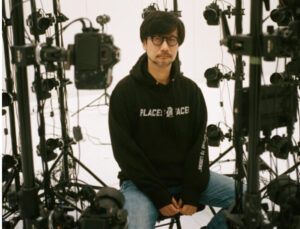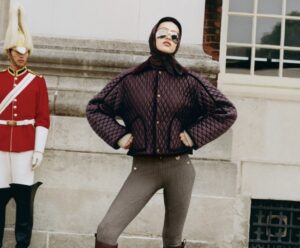A street corner glistens with recent rain. Its cobblestones shimmer under low amber light, as if time paused mid-breath. There’s a laundromat—open 24 hours—a faded beacon behind a curved pane of blue-tinted glass. Neon letters proclaim OPEN, their glow leaking across the wet pavement, inviting not only the sleepless, the stained, and the solitary—but perhaps even the haunted.
This is the world MichaelDavitt captures in the photograph titled Clean Up Time—a poetic visual meditation that does more than document a nocturnal cityscape. It echoes. It listens. And it answers something within the viewer with subtle yet deliberate emotional cadence. In this image, memory and routine fold into each other like warm linens straight out of the dryer.
The choice to pair this work with Carol Egan’s song “Clean Up Time” suggests a deeper narrative symmetry. Egan’s track—a melancholic yet hopeful piece wrapped in intimate vocals and subdued jazz instrumentation—serves not just as a soundtrack, but a narrative key. The song speaks of emotional decluttering, inner maintenance, the sort of invisible housekeeping required to survive in a world so often out of order. “Clean up time,” she sings, in tones that feel both exhausted and empowered, “is never done alone.”
This sentiment underpins the image. While the laundromat may appear desolate, its illumination tells another story. Someone is inside. Or someone was just here. Or perhaps someone will be soon. The point is not the presence itself, but the suggestion of passage. It is this tension—the spectral hum of human trace—that binds photograph to melody.
The laundromat, in this frame, becomes more than a site of domestic task. It’s a liminal chapel. A place of ritual and release. The foggy windows conceal but also confess. One thinks of all the stories washed into those machines: the after-midnight confessions, the hurried silences, the mechanical roar over a heartbreak. One thinks of recovery—not just from dirt or sweat, but from grief, from failure, from the weight of a world that keeps spinning when all you want is pause.
Cinematic Quiet
There is also an unmistakable cinematic tone to the photograph—Wong Kar-wai by way of Tarkovsky. The colors are rich but hushed; the composition is clean yet loaded with atmosphere. Each element is considered: the curve of the street, the angle of the signage pole, the blue ambient light from the apartment windows, the amber reflection slicing across wet stone. It feels like the establishing shot of a film that doesn’t need to be watched to be understood.
And yet, in its stillness, the image hums. It invites the eye to search—just like the song encourages the soul to sift. This is where Michaeldavitt’s work transcends medium: the viewer doesn’t simply see the laundromat; they are asked to remember one. The rain-slicked sidewalks. The buzz of fluorescents. The hush of early morning. The smell of detergent lingering in the air like a half-finished sentence.
Resonance and Ritual
There’s something fundamentally democratic about laundromats. They level everyone down to the human necessities: clean clothes, waiting, repetition. In Egan’s lyrical composition, this kind of repetitive cleansing becomes metaphorical. “You take what’s broken and sort it in piles,” she sings, “rinse the guilt out, fold the lies.” The alignment with this image is uncanny. The photograph too is about layers—of light, of time, of meaning.
Michaeldavitt could have chosen to depict a grander structure, or a busier scene. But the choice of a corner laundromat, empty and dimly lit, speaks volumes. It centers the ordinary, elevates the unspoken rituals we all share. It finds beauty not in spectacle, but in rhythm. Just as Carol Egan’s song isn’t about resolution but about process, so too is this image about the quiet dignity of effort.
Temporal Ambiguity
Time, in both the song and the photo, operates fluidly. The words “Open 24 hrs.” may suggest constant activity, yet what we’re shown is a moment suspended in stasis. Likewise, Egan’s lyrics oscillate between past and present, between what was broken and what is being rebuilt. There’s no definitive “before” or “after”—only the cycle.
In this way, Clean Up Time isn’t just a title. It’s a framework for how to read the world when the world doesn’t always make sense. Michaeldavitt’s visual interpretation mirrors Egan’s musical one: both ask the viewer to consider the hidden labor of healing, and to find stillness in its slow churn.
Reflections and Renewal
Perhaps the photograph’s most resonant feature is what it doesn’t show. We don’t see inside the machines. We don’t see the people. We don’t know what time it is. That uncertainty is deliberate. It opens a door. In a cultural landscape that often demands spectacle and resolution, this piece—and Egan’s music—dares to offer reflection instead. It’s not about arrival. It’s about recognizing the value of turning the cycle on again, of trying once more.
The cobblestones gleam like polished memory. The building curves like a soft echo. The neon light blinks with persistence. It may be late. It may be early. But the laundromat is open. And somewhere inside, someone is sorting their sorrows by fabric weight.
Flow
If Michaeldavitt’s photograph is the outer expression of place, and Egan’s “Clean Up Time” is the inner narration of emotional labor, then together they form a duet of contemporary solitude and endurance. They both present cleansing—not as glamour, not as erasure, but as a necessary, human act. And in doing so, they ask: what do we carry in with us? What do we leave behind?
“Clean up time,” in this light, becomes a lifelong act. A habit of resilience. A grace given to the self. As long as there is grime in the world—be it physical or emotional—there will be laundromats glowing at corners like this, humming songs of gentle redemption.
No comments yet.








